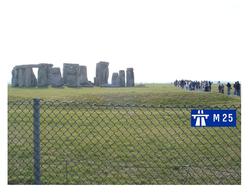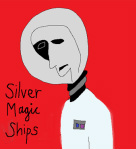
These "circular monuments" were places of great ceremonial and ritual significance that raise far more questions than answers (BBC 2010).
Perhaps future generations will be just as puzzled and intrigued by a modern-day "circular monument"? This was a phrase used by BBC journalist Mark Easton when reporting on the M25 – the orbital motorway that rings the British capital. He described it as "a circular monument to the urgent, constant and apparently endless nature of 24/7 metropolitan living" (Easton 2011).
Easton's words came to mind late last night as I arched my way around the M25. My drive took place on the eve of the road's twenty-fifth anniversary. For on this day exactly a quarter of a century ago the then British Prime Minister, Margaret Thatcher inaugurated this contemporary henge. She remarked in characteristic fashion:
Now some people are saying that the road is too small, even that it's a disaster.
I must say I can't stand those who carp and criticise when they ought to be
congratulating Britain on a magnificent achievement and beating the drum for
Britain all over the world (Thatcher 1986).
Motorists were indeed worshipping in such "enormous amounts" that, even as she declared the road complete, Mrs Thatcher announced plans to enlarge it. Included in this expansion was "the construction of a new bridge at Dartford" (Thatcher 1986).
This gave my late night pilgrimage around London and over the River Thames a doubly commemorative significance. Because tomorrow the Dartford Crossing will mark its twentieth anniversary: on 30th October 1991, the British monarch cut the ribbon on the Queen Elizabeth II Bridge.
Planes, trains and automobiles are utilitarian objects. Yet even a simple journey in an aeroplane can take place in a flying memorial. So, whilst motorways and bridges are functional things, they also have great heritage potential.
And who knows, perhaps this heritagisation will come full circle? Archaeologists thousands of years from now might uncover a huge 117-mile henge running around what appears to have been the site of a great metropolis. Was this a ritual site? A circular monument to some lost religion? If so, what sort of people came to worship there? In short, they will ask, how significant is the 'new henge'? (cf. Pitts 2010).
_________
References
BBC (2010) "Archaeologists unearth Neolithic henge at Stonehenge", BBC News, 22/07,
accessed 29/10/2011 at, http://www.bbc.co.uk/news/uk-england-10718522
Easton, Mark (2011) "Happy birthday M25", BBC News, 28/10,
accessed 29/10/2011 at, http://news.bbc.co.uk/today/hi/today/newsid_9626000/9626188.stm
Pitts, Mike (2010) "How significant is the 'new henge'?", BBC News, 22/07,
accessed 29/10/2011 at, http://www.bbc.co.uk/news/science-environment-10726307
Thatcher, Margaret (1986) "Speech opening final section of M25", 29/10,
accessed 29/10/2011 at, http://www.margaretthatcher.org/document/106506
__________
Supplemental
01/11/2011
Some unfortunate motorists have today had the opportunity to admire Britain's "magnificent achievement" for rather longer than anticipated. An accident early this morning has led to queues stretching for an estimated 19 miles...






